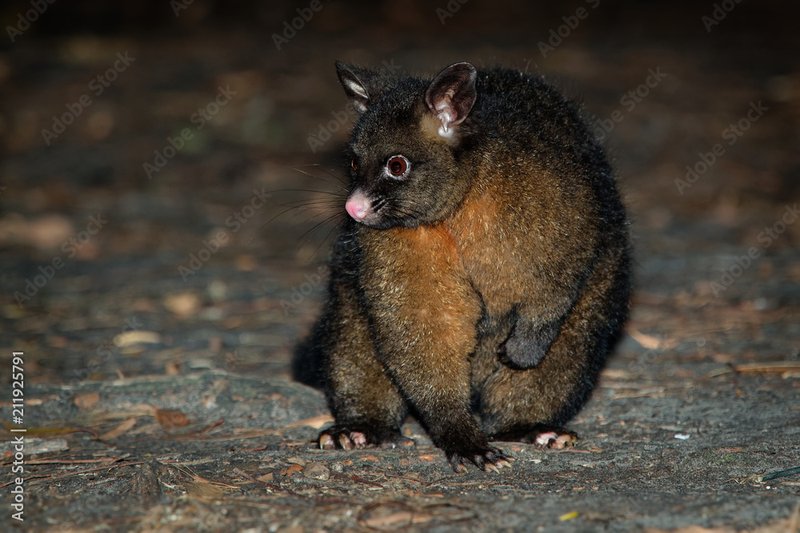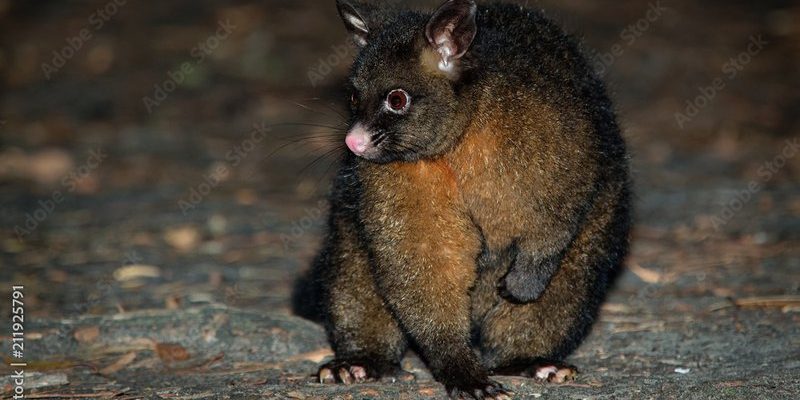
The Brush-Tailed Possum is a fascinating and adaptable marsupial native to Australia and New Guinea. These little nocturnal creatures are more than just cute faces; they play crucial roles in their ecosystems. Imagine a small, fluffy ball of fur, with a bushy tail that looks like it has its own personality. That’s our brush-tailed buddy! They are often seen scampering up trees, using their agile bodies and prehensile tails to navigate the branches with ease.
You might be wondering why these possums are so interesting. Aside from their adorable appearance, they have unique behaviors and habits that make them stand out. For instance, they are mostly nocturnal, meaning they become active at night, just like many other wild creatures. This lifestyle comes with its own set of challenges and adaptations that make them truly remarkable. So, let’s dive deeper into their world and uncover what makes the Brush-Tailed Possum such a special animal.
Physical Characteristics
When you first see a Brush-Tailed Possum, one of the standout features is its thick, bushy tail, which can be almost as long as its body. This tail isn’t just for show; it helps them maintain balance as they traverse their arboreal habitats. These possums typically weigh between 2.5 to 5.5 kilograms (5.5 to 12 pounds) and measure around 24 to 36 centimeters (9 to 14 inches) in body length. Their fur is thick and ranges from grey to brown, often with a lighter underside. This coloration helps them blend into their forest environments, providing a layer of camouflage from potential predators.
An interesting fact is that the Bush-Tailed Possum has a characteristic pointed snout and large, expressive eyes, which are perfect for night vision. Their ears are also large and rounded, contributing to their excellent hearing. When you think of this possum, imagine a petite creature with features designed perfectly for its environment. In essence, nature has equipped them wonderfully to thrive in their habitats.
Habitat and Distribution
Brush-Tailed Possums are versatile creatures, found in a wide variety of habitats across Australia, Tasmania, and New Guinea. They thrive in forests, woodlands, and even urban areas, showcasing their remarkable adaptability. You might spot them clambering around in tree canopies or settling in hollows for a good night’s sleep. The more lush and green the environment, the more likely you are to encounter one of these furry critters.
These possums prefer habitats with plenty of tree cover, as they’re predominantly arboreal. They’re excellent climbers, using their sharp claws and strong limbs to navigate between branches effortlessly. Interestingly, they can also be found in suburban areas, where they often forage for food, making them a common sight in parks and gardens at night. Their ability to thrive in different environments is a testament to their resilience and adaptability as a species.
Diet and Feeding Habits
Brush-Tailed Possums are primarily herbivorous, munching on a diverse diet of leaves, fruits, and flowers. Their preference varies depending on the season and availability of food sources. Eucalyptus leaves are a particular favorite, and they can consume a significant amount daily. You might find them feasting nonchalantly in a tree, their long fingers elegantly grasping their chosen snacks. They are also known to enjoy some delicious fruits and veggies, making them a favorite among those who love to observe wildlife.
An interesting aspect of their feeding habits is their ability to adapt to different food sources. This adaptability ensures they can survive in various environments, even urban settings. They tend to be nocturnal foragers, stepping out after dark to avoid potential predators and competition for food. Their keen sense of smell plays a crucial role in locating tasty treats, especially in the dense foliage of their habitats.
Behavior and Social Structure
Brush-Tailed Possums are generally solitary animals, although they can show social behaviors when it comes to mating or raising young. Male possums are known to be quite territorial, often marking their areas with scent to ward off rivals. However, during the breeding season, you might see them engaging in playful antics with potential mates. It’s a bit like a dance, where they exhibit displays of strength and agility to attract partners.
They also communicate with each other through vocalizations, body language, and scent marking. These sounds can range from soft grunts to loud barks, especially when they feel threatened or are expressing distress. Their social behaviors are fascinating, as they navigate their environments with a blend of independence and strategic interaction with their kind. This ability to connect, even if briefly, makes the Brush-Tailed Possum a unique character in the animal kingdom.
Reproduction and Lifecycle
The reproductive cycle of the Brush-Tailed Possum is quite interesting. Mating typically occurs in the autumn, and after a gestation period of about 17 days, females give birth to one or two young, commonly called joeys. These tiny, hairless babies are incredibly vulnerable at birth and spend the first several months of their lives clinging to their mother’s pouch. It’s a touching sight, as the mother carries her babies close until they are large enough to venture out.
As the joeys grow, they begin to explore outside the pouch while still relying on their mother for nourishment and protection. By about six months of age, they are weaned and start to learn how to forage for food. This extended care from their mother helps ensure that they develop the necessary skills to survive in the wild. By the time they are about one year old, they begin to venture off on their own, leaving the safety of their mother to establish their territories.
Conservation Status
Currently, the Brush-Tailed Possum is not considered endangered, but various factors threaten its populations. Habitat destruction due to urbanization, logging, and agriculture poses significant risks. Additionally, road traffic and predation by introduced species such as foxes and cats can impact their numbers. Conservation efforts are focused on protecting their habitats and promoting awareness about their ecological importance.
Community engagement plays a vital role in these efforts. Many wildlife organizations work hard to educate the public about the significance of preserving natural habitats for Brush-Tailed Possums and other native species. Encouraging responsible land use and creating wildlife corridors can help these possums continue thriving alongside our expanding cities. It’s a reminder that our actions can significantly impact the balance of these delicate ecosystems.
Table of Quick Facts about Brush-Tailed Possum
| Scientific Name: | Trichosurus vulpecula |
| Weight: | 2.5 – 5.5 kg (5.5 – 12 lbs) |
| Length: | 24 – 36 cm (9 – 14 in) |
| Lifespan: | Up to 13 years in the wild |
| Diet: | Herbivorous; leaves, fruits, flowers |
| Habitat: | Forests, woodlands, and urban areas |
| Activity: | Nocturnal |
Interactions with Humans
The presence of Brush-Tailed Possums in urban areas can create mixed feelings among residents. Some people enjoy spotting these adorable creatures in their gardens, while others might see them as pests. It’s not uncommon for possums to rummage through rubbish bins or nibble on pet food left outside. Their nocturnal habits can sometimes lead to conflict, especially if they decide to set up a cozy nesting site in an attic or shed.
However, it’s essential to remember that these encounters typically stem from the possum’s search for food and shelter. Educating the public on how to coexist with these creatures can lead to better outcomes for both humans and possums. Simple strategies, such as securing rubbish bins and removing attractants, can make a significant difference. After all, they are just trying to survive, much like any other animal.
Fun Facts about Brush-Tailed Possums
Now, let’s take a light-hearted look at some fun facts that make the Brush-Tailed Possum even more interesting:
- They have a remarkable sense of smell, which helps them locate food at night.
- Brush-Tailed Possums can rotate their ankles, allowing them to climb down trees headfirst.
- These possums can leap over 3 meters (about 10 feet) in a single bound!
- They are known to have very expressive faces, which can show a range of emotions.
- Their nocturnal lifestyle makes them a favorite subject for night-time wildlife enthusiasts.
FAQ
What do Brush-Tailed Possums eat?
Brush-Tailed Possums primarily eat leaves, fruits, and flowers. They have a particular fondness for eucalyptus leaves, which are abundant in their habitat. Their diet can vary seasonally, depending on what is available, and they are known to enjoy fruits and other plants found in urban gardens.
Are Brush-Tailed Possums dangerous to pets?
Generally, Brush-Tailed Possums are not dangerous to pets. However, they can become aggressive if cornered or threatened. It’s essential to supervise pets when they are outside, especially at night, to ensure they don’t have conflict with any wildlife, including possums.
How long do Brush-Tailed Possums live?
In the wild, Brush-Tailed Possums can live up to 13 years. Their lifespan can be shorter in urban areas due to hazards like traffic, predators, and disease. Proper conservation efforts can help improve survival rates, ensuring these creatures thrive in their natural habitats.
Do Brush-Tailed Possums make good pets?
While they might appear cute and cuddly, Brush-Tailed Possums are wild animals and do not typically make good pets. They have specific dietary and environmental needs that are challenging to meet in captivity. It’s best to appreciate them in their natural environments to ensure their welfare and well-being.
What sound does a Brush-Tailed Possum make?
Brush-Tailed Possums are known for their vocalizations, which can include soft grunts and loud barks. These sounds are used to communicate with one another, especially when threatened or during the mating season. Their vocal expressions can be quite an entertaining aspect of observing them in the wild!
How can I help protect Brush-Tailed Possums?
You can help protect Brush-Tailed Possums by advocating for preserving their habitats and creating awareness about their ecological importance. Taking steps to secure your garbage, planting native flora, and supporting local wildlife organizations can all contribute to their conservation efforts.
Are Brush-Tailed Possums solitary or social animals?
Brush-Tailed Possums are generally solitary creatures, especially males who are territorial. However, during the mating season, they can display social behaviors. They communicate through vocal sounds and markings, showing they have some degree of interaction with one another.
What role do Brush-Tailed Possums play in their ecosystem?
Brush-Tailed Possums play an essential role in their ecosystems by aiding in seed dispersal and helping to maintain the health of trees and plants in their habitats. As they feed on fruits and leaves, they contribute to the growth and regeneration of plant life, making them crucial players in their environments.

